Small Teams for Successful Digital Efforts
Originally published as part of, “The Day Before Digital Transformation” by Phil Perkins and Cheryl Smith
There is a lesson that successful digital leaders have learned. It is the importance of breaking digital efforts into components that can be addressed by small teams. The glory days of IT projects that have hundreds of people assigned to them are over. The success rates of those projects were low then and are close to zero in a digital world.
Digital transformation typically crosses the boundaries between multiple departments within an organization. Success requires close collaboration across strategy, product, industrial design, experience design, mechanical engineering, data science, electrical engineering, back-end IT infrastructures and platforms, and more, implying the need for even larger teams than in the past.
And the intent is for the digital efforts to have a substantial cultural change impact inside the entire organization (even if customer or client or patient acceptance is still slow but growing).
So how are successful digital efforts run and managed?
Experienced digital leaders know to keep the teams involved in digital efforts small. A standard in the Digital Age is the Two Pizza Rule. The rule began at Amazon: no team should be so large that two pizzas cannot feed the whole group.[i] (This generally translates into less than eight-person teams.)
There is a tremendous amount of research and science that has gone into making the Amazon rule a standard today. The issue with large teams is not just the ability to manage a large number of people effectively. As an organizational psychologist and expert on team dynamics J. Richard Hackman points out, it is the number of links between people that begins to pose the problem.[ii] A team of 6 requires 15 communication connections to manage. A team of 12 requires 66. A team of 50 requires 1,225. (Figure 37) With each link, productivity decreases, and inaccuracies increase.

The Agile methodology we discuss in building a culture of engineering focuses on defining efforts to be delivered by small teams within short periods of time. Successful digital leaders know how to define efforts into components that can be developed by small teams that operate autonomously. Everyone else, i.e., the professionals from strategy, marketing, sales, operations, finance, and technology, are called upon when their specific knowledge or skills are needed.
[i] “Jeff Bezos’s Productivity Tip? The ‘2 Pizza Rule.’ This trick helps Amazon’s founder keep his meetings productive and useful,” Aine Cain, Inc. Magazine, June 7, 2017.
[ii] “Why Jeff Bezos’ Two-Pizza Team Rule Still Holds True in 2018,” Janet Choi, I Done This Blog, December 4, 2018.